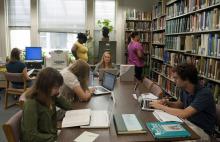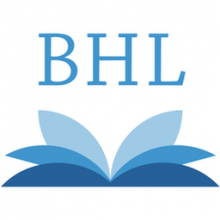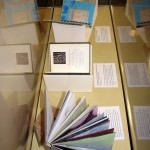 Below are a list of projects currently available for the Smithsonian Libraries Fall 2014 General Internship Program. Please help us spread the word about these opportunities!
Below are a list of projects currently available for the Smithsonian Libraries Fall 2014 General Internship Program. Please help us spread the word about these opportunities!

Jeremy Deller (British, 1966-) has been known for his art work that pulls his audience into actively discussing and confronting political, social, and historical issues. His video work English Magic (2012), on view now until August 2014 at the Hirshhorn Museum and Sculpture Garden, is an example of this dynamic. The film was selected for the British Pavilion at the 2013 Venice Biennale as the film served as a representation of British history through its interlacing imagery of the nation’s past and present.
The story of the last Passenger Pigeon and the disappearance of the Great Auk, Carolina Parakeet, and Heath Hen reveal the fragile connections between species and their environment. To help tell their story, the Smithsonian Libraries, Biodiversity Heritage Library, and the National Museum of Natural History have curated a joint exhibit entitled Once There Were Billions: Vanished Birds of North America which opened June 24 in the National Museum of Natural History.
Two hundred years ago, the passenger pigeon (Ectopistes migratorius) was the most abundant bird species in North America. A population numbering in the billions, as much as 40% of all land birds on the continent shared the same genome as Martha. Migrating flocks were so large that they literally blocked out the sky, stretching up to a mile wide and 300 miles long and taking 14 hours to pass a single point. Flocks were so densely packed that a single shot could bring down dozens of birds. The beat of up to 3.5 billion pairs of wings literally created its own cold front below, and those unaccustomed to the marvel feared the end of the world was upon them.
The Smithsonian Libraries is pleased to announce the new Neville-Pribram Mid-Career Educators Awards! These awards allow mid-career educators to be in residence and utilize the Smithsonian Libraries distinctive collections, focusing on science, history, culture and arts. The awards are open to middle & high school teachers, college teachers, and museum educators working on curriculum development or publications in print or electronic form.
 The Biodiversity Heritage Library, headquartered at the Smithsonian Libraries, welcomes the University of Illinois (Urbana-Champaign, Ill.) and Washington University (St. Louis, Mo.) as new partners. These two institutions will contribute to the digitization of historical science literature in the BHL collections. All material will be online, free, and available to the public.
The Biodiversity Heritage Library, headquartered at the Smithsonian Libraries, welcomes the University of Illinois (Urbana-Champaign, Ill.) and Washington University (St. Louis, Mo.) as new partners. These two institutions will contribute to the digitization of historical science literature in the BHL collections. All material will be online, free, and available to the public.
The story of the last Passenger Pigeon and the disappearance of the Great Auk, Carolina Parakeet, and Heath Hen reveal the fragile connections between species and their environment. To help tell their story, the Smithsonian Libraries, Biodiversity Heritage Library, and the National Museum of Natural History have curated a joint exhibit entitled Once There Were Billions: Vanished Birds of North America which opened June 24 in the National Museum of Natural History.

—This post was contributed by Rita Sausmikat and Maya Riser-Kositsky, interns at the American Art Museum/National Portrait Gallery (AA/PG) Library summer 2014.
An “artist’s book” can generally be defined as a work of art in book form, though this guideline is interpreted and finessed to fit the artist’s vision. Commonly, artists’ books are portable and interactive, and utilize a plethora of methods, technologies, and materials. Just as with artwork, artists’ books often tell a story, stir emotion, or convey a purpose.